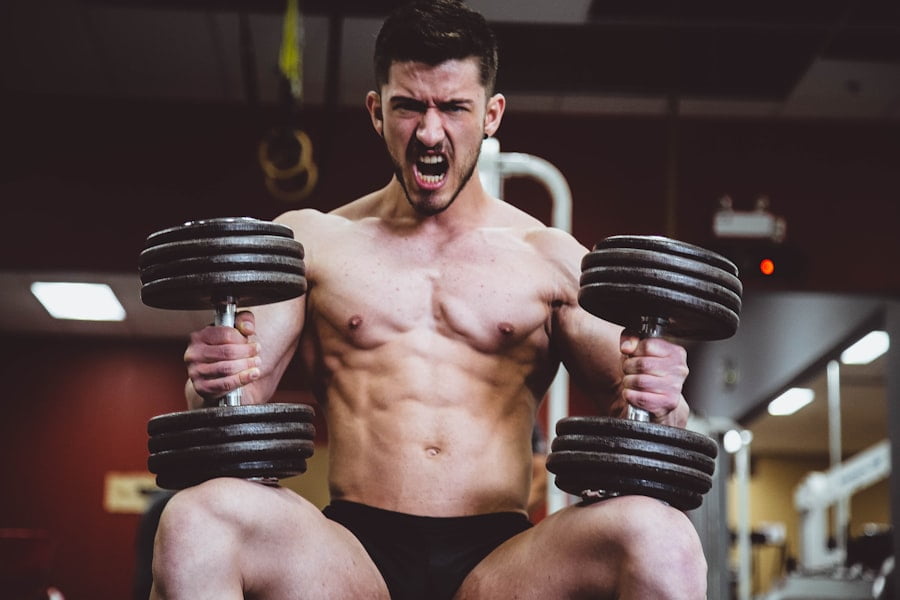
Chisel Your Chest: Effective Pec Workouts to Target and Sculpt Your Chest Muscles
Chest workouts are an essential part of any fitness routine. A well-defined chest not only looks impressive but also has numerous benefits, including improved posture and increased upper body strength. Whether you’re a beginner or an experienced lifter, incorporating chest exercises into your workout routine can help you achieve your fitness goals.
Key Takeaways
- A well-defined chest has numerous benefits
- Understanding the anatomy of chest muscles is important
- Effective warm-up exercises are crucial for chest workouts
- Weighted exercises like bench press are effective for chest workouts
- Proper form, rest, and recovery are key for effective chest workouts
Anatomy of the Chest Muscles
To effectively target and develop your chest muscles, it’s important to understand the different muscles that make up the chest. The main muscles of the chest include the pectoralis major and pectoralis minor. The pectoralis major is the larger muscle and is responsible for the bulk of the chest development. The pectoralis minor is a smaller muscle that lies underneath the pectoralis major and helps with shoulder movement.
During chest workouts, it’s important to target each of these muscles to achieve balanced development. This can be done by incorporating exercises that target different angles and ranges of motion. By targeting each muscle group, you can achieve a well-rounded and defined chest.
Warm-Up Exercises
Before diving into your chest workout, it’s crucial to warm up your muscles to prevent injury and improve performance. Effective warm-up exercises for the chest include arm circles and chest stretches.
Arm circles involve standing with your feet shoulder-width apart and extending your arms out to the sides. Begin by making small circles with your arms, gradually increasing the size of the circles as you warm up. This exercise helps to loosen up the shoulder joints and prepare them for the upcoming workout.
Chest stretches involve standing with your feet shoulder-width apart and interlocking your fingers behind your back. Slowly raise your arms behind you, keeping them straight, until you feel a stretch in your chest muscles. Hold this position for 15-30 seconds before releasing. This stretch helps to open up the chest muscles and increase flexibility.
Bodyweight Exercises
| Exercise | Difficulty | Primary Muscles Worked | Calories Burned (per minute) |
|---|---|---|---|
| Push-ups | Beginner to Advanced | Chest, Triceps, Shoulders | 7-10 |
| Squats | Beginner to Advanced | Quadriceps, Hamstrings, Glutes | 5-8 |
| Lunges | Beginner to Advanced | Quadriceps, Hamstrings, Glutes | 6-9 |
| Plank | Beginner to Advanced | Core | 2-3 |
| Mountain Climbers | Intermediate to Advanced | Core, Shoulders, Legs | 8-12 |
Bodyweight exercises are a great way to target the chest muscles without the need for equipment. Push-up variations are particularly effective for chest development. Diamond push-ups involve placing your hands close together in a diamond shape, with your thumbs and index fingers touching. Lower your body down towards the ground, keeping your elbows close to your sides, and then push back up to the starting position. This exercise targets the inner chest muscles.
Decline push-ups involve elevating your feet on a bench or step, placing your hands slightly wider than shoulder-width apart on the ground. Lower your body down towards the ground, keeping your elbows close to your sides, and then push back up to the starting position. This exercise targets the upper chest muscles.
Dips are another effective bodyweight exercise for targeting the chest muscles. To perform dips, find parallel bars or use two sturdy chairs placed shoulder-width apart. Lower your body down by bending your elbows until your upper arms are parallel to the ground, and then push back up to the starting position. This exercise targets both the pectoralis major and pectoralis minor.
Weighted Exercises
Weighted exercises are a great way to add resistance and increase the intensity of your chest workouts. The barbell bench press is a classic exercise that targets the entire chest. Lie flat on a bench with your feet firmly planted on the ground and grip the barbell slightly wider than shoulder-width apart. Lower the barbell down towards your chest, keeping your elbows at a 45-degree angle, and then push it back up to the starting position.
The dumbbell bench press is another effective exercise for targeting each side of the chest individually. Lie flat on a bench with a dumbbell in each hand, palms facing forward. Lower the dumbbells down towards your chest, keeping your elbows at a 45-degree angle, and then push them back up to the starting position.
The incline bench press is a variation of the bench press that targets the upper chest muscles. Set the bench to a 45-degree angle and perform the exercise in the same way as the barbell or dumbbell bench press. This exercise helps to develop a well-rounded and defined chest.
Cable Exercises

Cable exercises are a great way to add variety to your chest workouts and target specific areas of the chest. The cable fly is an effective exercise for targeting the inner chest muscles. Stand in the middle of a cable machine with the handles at shoulder height. Step forward with one foot and bring your hands together in front of your chest, keeping your elbows slightly bent. Slowly pull your hands apart, squeezing your chest muscles, and then bring them back together.
The incline cable fly is a variation of the cable fly that targets the upper chest muscles. Set the bench to a 45-degree angle and perform the exercise in the same way as the cable fly. This exercise helps to develop a well-rounded and defined upper chest.
The standing cable crossover is an exercise that targets the outer chest muscles. Stand in the middle of a cable machine with the handles at shoulder height. Step forward with one foot and bring your hands together in front of your chest, keeping your elbows slightly bent. Slowly pull your hands apart, squeezing your chest muscles, and then bring them back together.
Plyometric Exercises
Plyometric exercises are explosive movements that help to develop power and strength in the chest muscles. Plyometric push-ups are a great exercise for explosive power and strength. Start in a push-up position and lower your body down towards the ground. As you push back up, explode off the ground, clapping your hands together before landing softly back in the starting position.
The medicine ball chest pass is another effective plyometric exercise for targeting the chest muscles and improving coordination. Stand facing a wall with a medicine ball in both hands at chest height. Push the ball forward with both hands, extending your arms fully, and then catch it as it bounces back towards you.
Clap push-ups are a challenging plyometric exercise that increases upper body explosiveness. Start in a push-up position and lower your body down towards the ground. As you push back up, explode off the ground, clapping your hands together before landing softly back in the starting position.
Isolation Exercises
Isolation exercises are great for targeting specific areas of the chest and achieving maximum muscle activation. The chest squeeze is an effective exercise for targeting the inner chest muscles. Stand with your feet shoulder-width apart and hold a resistance band or towel in front of your chest with both hands. Pull the band or towel apart, squeezing your chest muscles, and then release.
The chest press machine is another effective isolation exercise for targeting the chest muscles. Sit on the machine with your back against the pad and grip the handles at chest height. Push the handles forward, extending your arms fully, and then bring them back towards your chest.
The pec deck fly is an isolation exercise that targets the outer chest muscles. Sit on the machine with your back against the pad and grip the handles at shoulder height. Bring your arms together in front of your chest, squeezing your chest muscles, and then slowly bring them back to the starting position.
Tips for Effective Chest Workouts
To get the most out of your chest workouts, it’s important to focus on proper form and technique for each exercise. This ensures that you’re targeting the right muscles and minimizing the risk of injury. It’s also important to listen to your body and give yourself enough rest and recovery time between workouts. This allows your muscles to repair and grow, leading to continued muscle development.
Progressive overload is another important aspect of effective chest workouts. This involves gradually increasing the weight or intensity of your exercises over time to challenge your muscles and promote growth. This can be done by adding more weight to your barbell or dumbbells, increasing the number of repetitions or sets, or incorporating more challenging variations of the exercises.
Incorporating chest workouts into your fitness routine is essential for overall upper body strength and posture improvement. By targeting the different muscles of the chest through a variety of exercises, including bodyweight, weighted, cable, plyometric, and isolation exercises, you can achieve a well-defined and balanced chest. Remember to focus on proper form and technique, give yourself enough rest and recovery time, and gradually increase the intensity of your workouts for continued muscle development. With dedication and consistency, you can achieve your chest goals and improve your overall fitness.
FAQs
What are pec workouts?
Pec workouts are exercises that target and strengthen the pectoral muscles, which are the muscles located in the chest area.
Why is it important to target and sculpt the chest muscles?
Targeting and sculpting the chest muscles can improve posture, increase upper body strength, and enhance overall physical appearance.
What are some effective pec workouts?
Effective pec workouts include push-ups, bench press, dumbbell flyes, cable crossovers, and chest dips.
How often should I do pec workouts?
It is recommended to do pec workouts 1-2 times per week, with at least 48 hours of rest in between workouts to allow for muscle recovery.
Can pec workouts be done at home?
Yes, many pec workouts can be done at home with little to no equipment, such as push-ups and dumbbell flyes. However, some exercises may require gym equipment, such as bench press and cable crossovers.
Are there any precautions I should take when doing pec workouts?
It is important to use proper form and technique when doing pec workouts to avoid injury. It is also recommended to start with lighter weights and gradually increase as strength improves. If you have any pre-existing medical conditions or injuries, consult with a healthcare professional before starting any new exercise routine.

















